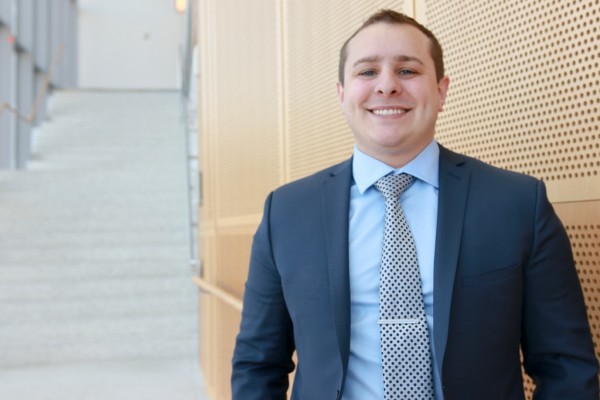 Fabrice Mowbray (MScN 2017) hopes his research into non-urgent emergency department use by patients with mental illness will ease congestion in area hospitals.
Fabrice Mowbray (MScN 2017) hopes his research into non-urgent emergency department use by patients with mental illness will ease congestion in area hospitals.
Patients seeking help for mental illness often turn to emergency departments for psychiatric care, further adding to overcrowding found in hospitals across the province, says a UWindsor nursing graduate.
Fabrice Mowbray said this overcrowding has been found to increase poor patient outcomes, burn-out among emergency department (ED) staff, and create longer wait times for those in need.
It’s an issue becoming increasingly dire, and Mowbray said that there are measures we can take to help decrease this congestion.
“We know that mental illness is on the rise — both the prevalence and the incidence rate — and we know that with such rise, we are going to see more people seeking mental health care,” said Mowbray (MScN 2017).
A study done by Mowbray’s supervisor, nursing professor Maher El-Masri, shed light on the fact that patients seeking mental health care contribute a higher proportion of visits in Windsor-Essex EDs than those seeking care for diabetes, chronic obstructive pulmonary disease, and coronary heart disease.
“Unfortunately, roughly 1/3 of visits taking place in EDs for mental health care are for non-urgent psychiatric complaints, and the literature shows that the ED is not a conducive environment for the treatment of mental illness," he said.
In his Master’s thesis, Mowbray explored the factors associated with non-urgent emergency department use by people with mental illness in Windsor and Essex County. To his knowledge, this is the first study to examine this topic in North America.
He identified eight factors that are predictive of non-urgent ED use by individuals seeking mental health care: age, season, time of day, access to primary health care, mode of arrival, hospital type, patient diagnosis and, referral source.
“We found that the older the patient is, the more likely they are to use the ED for a non-urgent reason,” he explained. “We think that as individuals age with their illness, they learn the subtle cues that present prior to a major psychiatric breakdown, and seek care prior to the development of any serious consequences.”
One factor whose impact surprised Mowbray was the referral source.
“We discovered that you were more likely to use the ED for a non-urgent psychiatric complaint if you were referred by a primary care provider, and that defeats the purpose of primary health care,” Mowbray said. “If a primary care provider sends you to the ED, it should be for an urgent reason.”
While it’s difficult to know the exact reason, Mowbray said he has some theories.
“In Ontario, physicians are billed the same whether they assess and treat you for a stubbed toe or a psychiatric complaint; mental health related visits are more likely to take a significant amount of time,” he said. “Most general practitioners only have a finite amount of time with their patients, and may defer the care to ensure the greatest number of patients are seen in clinic.”
Another possibility is that physicians use the ED as a “safety net.”
“The literature shows that primary care physicians are often uncomfortable dealing with mental illness, and we hypothesize that they often send patients to the ED when they feel unable to provide optimal patient care,” Mowbray said.
He said a mental illness is a broad term that could include anything from suicidal ideation to anxiety to substance abuse.
As a registered nurse in the emergency department at the DMC Children’s Hospital of Michigan, Mowbray said it’s frustrating to see patients with mental illness come into the emergency department for primary health care.
“Generally speaking, EDs have a lack of time, a lack of specialists, and it’s difficult to provide privacy for these patients,” he said. “People receiving treatment for mental illness require a non-stimulating environment, in-depth discussion, and follow-up. Unfortunately, EDs do not have the resources or space for that.”
Mowbray said he hopes his research, through the eight identified factors, helps assist in the identification of people who are at an increased risk for non-urgent visits to emergency.
“I am hoping to disseminate this research to clinicians, educators, and key stakeholders so they can use this information,” Mowbray said. “I hope that they will be able to use the findings of my research to not only educate people who are at an increased risk, but to also help identify them and allocate the appropriate resources to assist them.”

